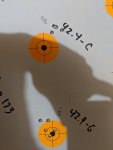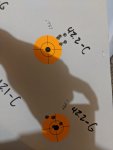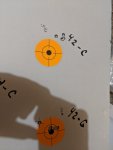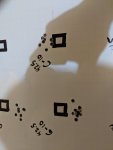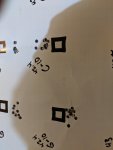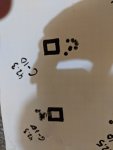All,
So yesterday I took my Daniel Defense DD5v5 (20" 1:8 twist AR-10) to the local 100 yard range to shoot a series of different charges to find a decent load recipe to go with. I would like to ask for help on analyzing my results, and request some suggestions on what I could do better for next time. Below will you will find both the chronograph data from a magneto speed v3 and the shot groupings from the targets.
First, I want to say that yesterday was really hot (90 degrees) and due to the range closing relatively soon, I was forced to shoot these strings more quickly than I would have liked. I personally believe that the barrel didn't have the ability to adequately cool down between strings because of this.
After looking over the shot results, I felt like the groupings recorded on paper didn't have any obvious results, at least to my novice eyes. I was really hoping to have really tight and really loose groups, which would clearly indicate what loads were best and worst. When I look at them they seem very similar across all shot strings.
Any and all advice and suggestions would be greatly appreciate. THANKS IN ADVANCE!
**load data was used from Sierra**
Cartridge Specs:
-140gr SMKs
-Remington 6.5CM reloaded brass
-Winchester LG rifle primers
-COL: 2.818"
-Powder: Reloder 17. Charges dropped by RCBS Chargemaster @ (34gn, 35.7gn, 37.4gn, 39gn, 40.7gn, 41.5gn, 42.3gn)


Chronograph Data:

So yesterday I took my Daniel Defense DD5v5 (20" 1:8 twist AR-10) to the local 100 yard range to shoot a series of different charges to find a decent load recipe to go with. I would like to ask for help on analyzing my results, and request some suggestions on what I could do better for next time. Below will you will find both the chronograph data from a magneto speed v3 and the shot groupings from the targets.
First, I want to say that yesterday was really hot (90 degrees) and due to the range closing relatively soon, I was forced to shoot these strings more quickly than I would have liked. I personally believe that the barrel didn't have the ability to adequately cool down between strings because of this.
After looking over the shot results, I felt like the groupings recorded on paper didn't have any obvious results, at least to my novice eyes. I was really hoping to have really tight and really loose groups, which would clearly indicate what loads were best and worst. When I look at them they seem very similar across all shot strings.
Any and all advice and suggestions would be greatly appreciate. THANKS IN ADVANCE!
**load data was used from Sierra**
Cartridge Specs:
-140gr SMKs
-Remington 6.5CM reloaded brass
-Winchester LG rifle primers
-COL: 2.818"
-Powder: Reloder 17. Charges dropped by RCBS Chargemaster @ (34gn, 35.7gn, 37.4gn, 39gn, 40.7gn, 41.5gn, 42.3gn)
Chronograph Data:



